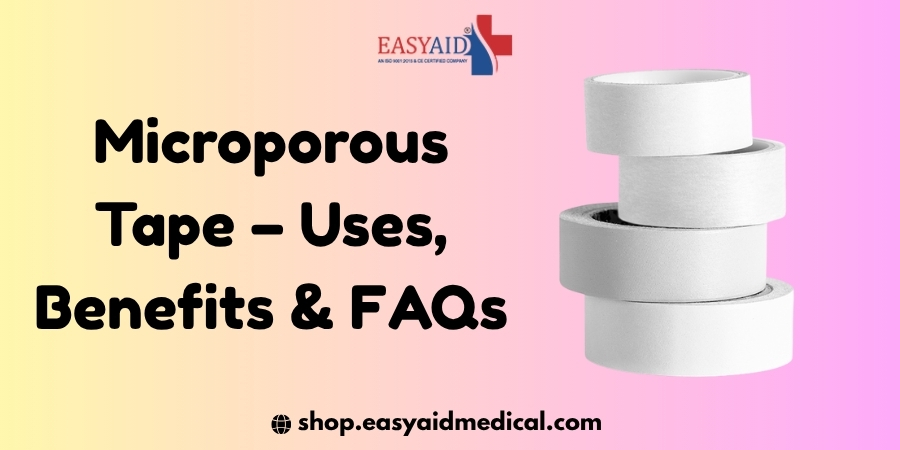Microporous tape, also called medical paper tape, is one of the most widely used disposable medical products in hospitals, clinics, and first aid kits. It helps secure dressings, bandages, and medical tubing while allowing the skin to breathe comfortably.
Below, we’ve answered the most common questions users and healthcare professionals ask about microporous tape — how to use it, its safety, and best care practices.
1. What is microporous tape?
Microporous tape is a breathable, hypoallergenic medical adhesive tape made of non-woven material. It is used to hold gauze, dressings, or bandages in place.
The “microporous” quality means that air and moisture vapor can pass through, helping keep the skin healthy and reducing irritation. It’s suitable for long-term wear and ideal for sensitive skin.
Also Read- Hot Water Rubber Bag – Uses, Benefits, and FAQ
2. What are the common uses of microporous tape?
Microporous tape is a multi-purpose medical tape used for:
- Securing wound dressings or sterile pads
- Fixing IV lines or catheters
- Taping light bandages and gauze
- Holding medical tubing during surgery or recovery
- Protecting delicate or healing skin after injury
Its gentle adhesive makes it perfect for babies, elderly patients, and people with sensitive skin.
3. Is microporous tape safe for sensitive skin?
Yes. Microporous tape is gentle, hypoallergenic, and latex-free, making it safe for most skin types.
However, if you have very sensitive or allergic skin, perform a patch test before long-term use. Stop using it if redness, itching, or irritation occurs.
4. How is microporous tape different from other medical tapes?
Microporous tape stands out because:
- It’s breathable, unlike plastic or waterproof tapes.
- It has gentle adhesion for long wear.
- It removes easily without damaging skin.
- It’s latex-free and lightweight, suitable for everyday use.
Other tapes (like zinc oxide or silk tape) are stronger but less suitable for delicate skin.
Also Read- Common FAQ About Nebulizer Machine
5. Can microporous tape get wet?
Microporous tape is not fully waterproof, but it can handle light moisture or sweat.
If it becomes too wet, the adhesive may weaken — replace it with a fresh piece of tape.
6. How to apply microporous tape correctly
To ensure proper adhesion and comfort:
- Clean and dry the skin.
- Apply the dressing or pad over the wound.
- Cut or tear the required length of tape.
- Smooth gently over the dressing edges.
- Avoid stretching the tape too tightly to prevent irritation.
7. How to remove microporous tape without pain
- Peel the tape slowly in the direction of hair growth.
- Hold the skin down while removing to reduce pulling.
- If it sticks too much, dab with warm water or use adhesive remover.
- Remove gently to avoid damaging healing skin.
8. How long can you wear microporous tape?
Microporous tape can typically be worn for 24–48 hours, depending on skin condition and moisture.
Replace sooner if it becomes wet, loose, or loses stickiness. Always check the wound area daily.
9. Can microporous tape be reused?
No. Microporous tape is designed for single use only.
Once removed, its adhesive weakens and may carry bacteria. Always use a fresh piece to prevent infection.
10. Can I use microporous tape on the face or delicate areas?
Yes. Microporous tape is gentle enough for use on the face, neck, or around the eyes (to secure medical pads).
Ensure the skin is clean, dry, and oil-free for better adhesion.
11. What sizes does microporous tape come in?
Microporous tape is available in:
Choose based on your wound or dressing size. Most rolls come in 5–10 meter lengths.
12. How to store microporous tape
Keep in a cool, dry place away from direct sunlight and humidity.
Avoid exposure to heat, which may weaken the adhesive. Always store it in its original packaging.
13. Can I use microporous tape for sports or exercise?
Microporous tape is not ideal for heavy sweating or physical activities.
For workouts, use sports tape or elastic adhesive bandages that are stronger and sweat-resistant.
14. Is microporous tape eco-friendly?
Most microporous tapes are made from partially biodegradable materials.
However, if used on open wounds, dispose of them responsibly as medical waste to prevent contamination.
15. What are some reliable microporous tape brands?
Top-quality global brands include:
- 3M Micropore™ Surgical Tape
- Hansaplast Microporous Tape
- Easypore™ Medical Microporous Tape
- Dynarex Paper Tape
- Medline Microporous Surgical Tape
Always buy from trusted pharmacies or verified online stores to ensure product authenticity and hygiene.

